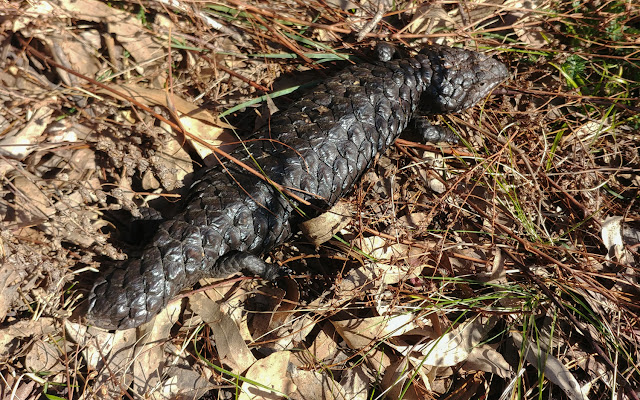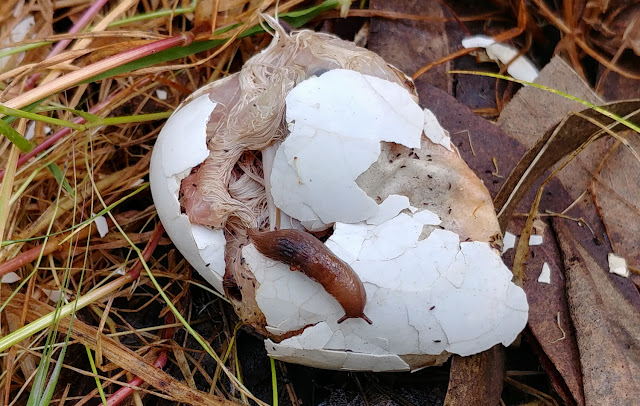Evidence of polygamy in the Tawny Frogmouth

An adult male Tawny Frogmouth sits second from the right between five fledglings.
I
recently found a brood of five fledgling Tawny Frogmouths Podargus strigoides
that were being attended by one adult male and two adult females. The birds
were first observed at the nest on 14 November 2024 and the birds were seen on several
subsequent visits to the nest area (up to 29 Dec 2024). The nesting area was in
dry sclerophyll forest on Black Mountain in the Australian Capital Territory
(ACT). As far as I can determine, this is the first record of a brood of five Tawny
Frogmouths.

The two adult
female Tawny Frogmouths, perched on the same branch on 29 November. Female A is at the top of the branch, female B lower down on the same branch.
The
observations were made while monitoring nests and broods as part of a long term
study of Tawny Frogmouth breeding ecology (18 years). Six trios of breeding
Tawny Frogmouths have been recorded previously in the study, although none with
more than three fledglings (1x1, 2x2, 2x3, 1x failed). These records have not
been published, I had planned to publish them in more context when all the data
are collected. However, due to the interest in this new record, I decided to
write a brief report that was published in the local bird club journal,
Canberra Bird Notes 49(2) see here. It is not known if one or both females laid the eggs in the nest in this instance.
Given that frogmouths usually lay 1-3 eggs it appears that both females in this
instance laid eggs and this was a polygamous relationship consisting of a
breeding trio. In the article, I pondered whether this was the
first record of a brood of five or of polygyny in any frogmouth species, or
polygyny in any of the Caprimulgiformes. The records for the frogmouths seem to
be the first of their kind, although there have been previous records of
polygyny in nightjar species.


Above left: Female A. She is overall more grey
than female B. There is less rufous colouring around the face and less
prominent streaks on the breast.
Above right: Female B. She is overall more rufous,
especially on the wing coverts and around the face. Her breast is more
obviously streaked.
The breeding biology of the Caprimulgiformes is poorly known
and they are generally thought to be monogamous (Cleere 2010). Polygyny has
seemingly only been documented in four species, the Standard-winged Nightjar Macrodipteryx
longipennis (Holyoak 2001), the Pennant-winged Nightjar M. vexillarius
(Jackson 2004), the White-winged Nightjar Caprimulgus candicans (Pople
2003), and European Nightjar Caprimulgus europaeus (Odder Jensen 2013,
Evens et al, 2024). The males of the first two species have exaggerated plumage
differences from the females, such as elongated feathers, which they use for
display in leks and so are considered to be polygynous. Male White-winged
Nightjar also display in dispersed (exploded) leks (Frith 2024) and have been
proved to mate with more than one female in a study using VHF radio tracking.
The European Nightjar has only recently been proved to be polygynous in studies
using GPS-telemetry.
A full report will be published on the breeding ecology of Tawny
Frogmouths in the ACT when the study is completed and a separate publication
will discuss polygyny in the species and other Caprimulgiformes.

The adult male frogmouth sits with four of the fledglings behind him, on 29 December. The other fledgling was with female A and female B was on a branch above them.
Cleere, N. & Nurney, D. (1998). Nightjars. – Pica
Press, Sussex
Evens, R., Lathouwers, M., Creemers, J., Ulenaers, E., Eens,
M., & Kempenaers, B. (2024). A Case of Facultative Polygyny in an Enigmatic
Monogamous Species, the European Nightjar (Caprimulgus
europaeus). Ecology and Evolution, 14(10): e70366.
Frith, C. B. (2024). Use and definitions of the terms arena,
lek and court in describing avian courtship sites. Ibis.
Holyoak, D.T. (2001): Nightjars and their allies: The
Caprimulgiformes. – Oxford University Press
Odder Jensen, N. (2013). A Case of Polyterritorial Polygyny
in European Nightjar Caprimulgus europaeus. Dansk Ornitologisk
Forenings Tidsskrift 107: 239–244.
Jackson, H. D. (2004). Courtship displays of the
Pennant-winged Nightjar, Semeiophorus vexillarius. Ostrich 75:
1-4.
Pople, R. G. (2003). The ecology and conservation of
the white-winged nightjar Caprimulgus candicans [Apollo - University of
Cambridge Repository]. https://doi.org/10.17863/CAM.16393





















































